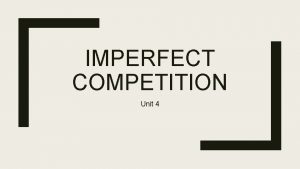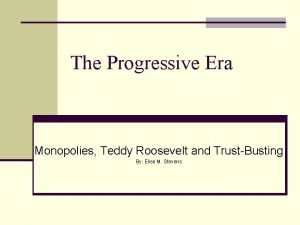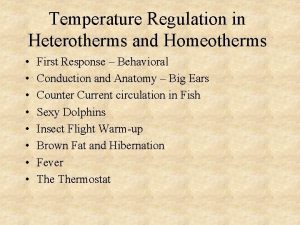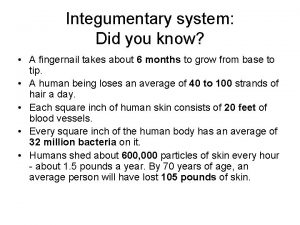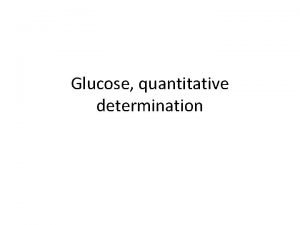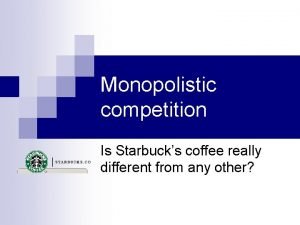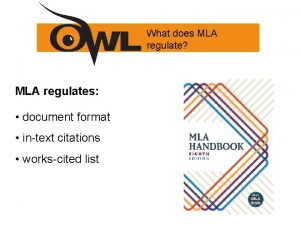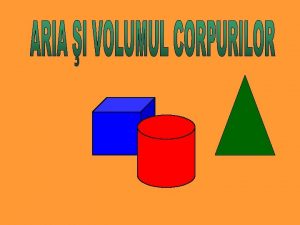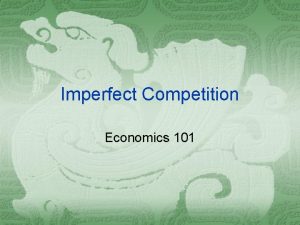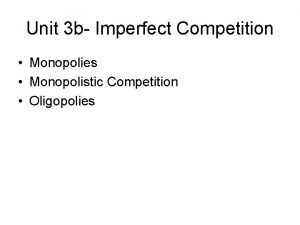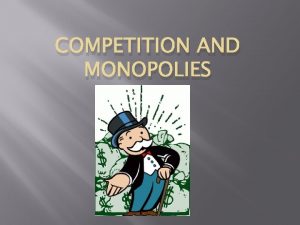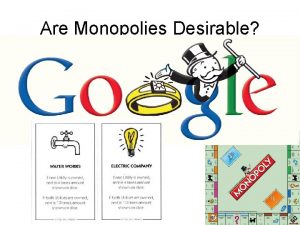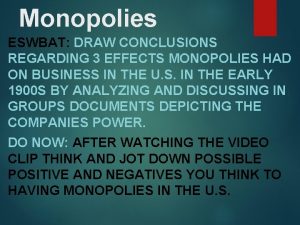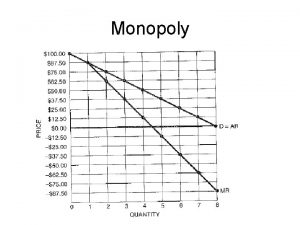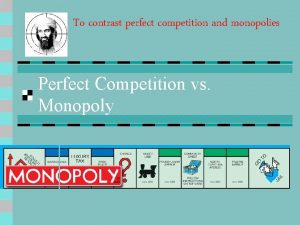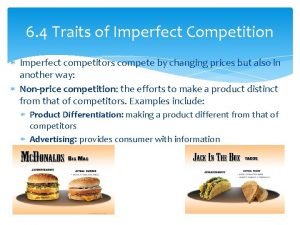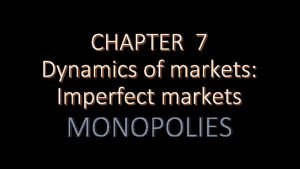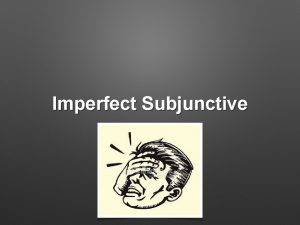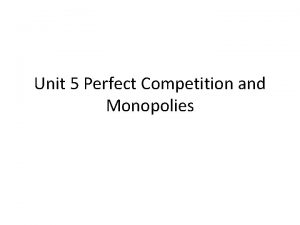Unit 4 Imperfect Competition Regulating Monopolies Why Regulate

























- Slides: 25

Unit 4: Imperfect Competition

Regulating Monopolies

Why Regulate? Why would the government regulate a monopoly? 1. To keep prices low 2. To make monopolies efficient How do they regulate? • Use Price controls: Price Ceilings • Why don’t taxes work? • Taxes limit supply and that’s the problem

Where should the government place the price ceiling? 1. Socially Optimal Price P = MC (Allocative Efficiency) OR 2. Fair-Return Price (Break–Even) P = ATC (Normal Profit)

Natural Monopoly One firm can produce the socially optimal quantity at the lowest cost due to economies scale. P It is better to have only one firm because ATC is falling at socially optimal quantity MC ATC MR D QSocially Q

Natural Monopoly Unregulated P Fair Return PM Socially Optimal (No DWL) MC PFR ATC QSO MR QM QFR D QSocially Q

Regulating a Natural Monopoly What happens if the government sets a price ceiling to get the socially optimal quantity? P The firm would make a loss and would require a subsidy MC ATC Pso MR D Qsocially optimal Q


The Use of Knowledge in Society Read the article and consider the following questions. 1. What is the main problem that Hayek is pointing out in this article? 2. What conclusion does Hayek draw as a result? 3. How can this argument be applied to the discussion of how to regulate a natural monopoly?

Perfect Price Discrimination

Price Discrimination: Practice of selling the same products to different buyers at different prices Examples: • Airline Tickets (vacation vs. business) • Movie Theaters (child vs. adult) • All Coupons (spenders vs. savers) • HS football games (students vs. parents)

Price Discrimination Price discrimination seeks to charge each consumer what they are willing to pay in an effort to increase profits. Those with inelastic demand are charged more than those with elastic Requires the following conditions: 1. Must have monopoly power 2. Must be able to segregate the market 3. Consumers must NOT be able to resell product

P $11 Qd TR MR 0 0 -

Results of Price Discrimination $10 P $11 $10 Qd TR MR 0 10 10

Results of Price Discrimination $10 $9 P $11 $10 $9 Qd TR MR 0 1 2 0 10 19 10 9

Results of Price Discrimination $10 $9 $8 P $11 $10 $9 $8 Qd TR MR 0 1 2 3 0 10 19 27 10 9 8

Results of Price Discrimination $10 $9 $8 $7 P $11 $10 $9 $8 $7 Qd TR MR 0 1 2 3 4 0 10 19 27 34 10 9 8 7

Results of Price Discrimination P $11 $10 $9 $8 $7 $6 $5 $4 $10 $9 $8 $7 $10 $9 $8 $7 $6 $5 $4 Qd TR MR 0 1 2 3 4 5 6 7 0 10 19 27 34 40 45 49 10 $9 $8 $7 $6 $5 $4

For price discriminating monopolies, the MR equals the demand Price Demand = MR Quantity

Non Price Discriminating Monopoly vs. Price Discriminating Monopoly P MC ATC Pm D MR Qm Q

A perfectly discriminating can charge each person differently so the Marginal Revenue = Demand P MC ATC D MR Q

A perfectly discriminating can charge each person differently so the Marginal Revenue = Demand Identify the Price, Profit, CS, and DWL P MC ATC D =MR Qnm Q

A perfectly discriminating can charge each person differently so the Marginal Revenue = Demand Identify the Price, Profit, CS, and DWL P MC ATC D =MR Qnm Q

A perfectly discriminating can charge each person differently so the Marginal Revenue = Demand Identify the Price, Profit, CS, and DWL P MC ATC D =MR Price Discrimination results in several prices, more profit, no CS, and a higher socially optimal quantity Qnm Q

Is Perfect Price Discrimination In Our Future? Read the two articles linked below. How are online retailers using data to price discriminate? How does your online behavior indicate your price sensitivity?
 Unit4 competitors
Unit4 competitors Trust busting progressive era
Trust busting progressive era Why why why why
Why why why why Monopolistic competition graph
Monopolistic competition graph Imperfect competition
Imperfect competition The most extreme form of imperfect competition is
The most extreme form of imperfect competition is Types of imperfect competition
Types of imperfect competition Perfect competition vs monopolistic competition
Perfect competition vs monopolistic competition Monopoly vs monopolistic competition
Monopoly vs monopolistic competition Market structure venn diagram
Market structure venn diagram Competition refers to
Competition refers to Homeotherms and heterotherms
Homeotherms and heterotherms Regulating body temperature
Regulating body temperature Fasting plasma glucose concentration
Fasting plasma glucose concentration Regulating body temperature
Regulating body temperature The process of evaluating and regulating ongoing activities
The process of evaluating and regulating ongoing activities Section 10-3 regulating the cell cycle
Section 10-3 regulating the cell cycle Steam traps ppt
Steam traps ppt Cardiac output is determined by
Cardiac output is determined by 10-3 regulating the cell cycle
10-3 regulating the cell cycle Dont ask
Dont ask Is the coffee market perfectly competitive
Is the coffee market perfectly competitive San romano ca
San romano ca Unit 10, unit 10 review tests, unit 10 general test
Unit 10, unit 10 review tests, unit 10 general test What does mla regulate?
What does mla regulate? Apotema bazei tetraedrului regulat
Apotema bazei tetraedrului regulat
